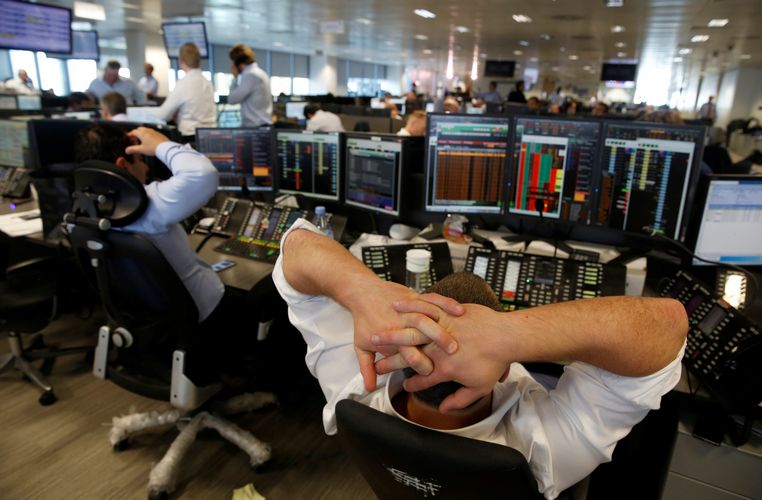As the US closed and Australia opened overnight I received a note from Melbourne sent by the venerable firm of Joseph Palmer & Sons entitled “Dead cat bounce?”. That’s a term I hadn’t heard in a while but I suppose the low volatility markets haven’t given rise to such an event.
There has always been some controversy as to where the term hails from although I have quite firmly believed that it reflects the calm observation that even a dead cat will bounce if it is dropped from high enough. I suppose one could add that if the Dow drops 1,175.21 points on Monday because equity markets are scared of rising inflation and accelerated Fed action but then regains 567.02 points on Tuesday, just 20 points less than half of the previous day’s losses, that they are now only half as scared as they were the day before.
Don’t believe it. With pundits having lined up to mark Monday’s price action as a healthy correction, would that make yesterday’s equally significant bounce a return to ill-health? At this point it’s hard to tell. The VIX seems to be where most of the action took place. Rumours abound of huge losses having been generated by leveraged inverse volatility plays and the intraday trading chart of the VIX for yesterday reflects some very serious activity. Having closed at 37.32 on Monday, up 20.01 points, it then went bananas on Tuesday. Rising in steps and stages to over 50 it then dropped in early morning Chicago trading from 49.27 to 22.42 in just 38 minutes. 40 minutes later it was back at 46.34, only to close at 29.98, down 7.34 on the day.
Spock would have looked at Captain Kirk and said “That’s not logical, captain”, which it most certainly wasn’t although given the way in which investors have again and again sucked up leveraged yield enhancement plays to help them through a low-yielding investment environment it should not come as a surprise. In 1994 it was so-called bull notes. In 2007 it was CDOs. Now it is leveraged inverse volatility structures. To make things worse, these structures were packed into ETFs, which some people believe to contain some sort of magic that makes them special. What part of the law of physics don’t people get that risk can be converted but it can’t be destroyed and that when it is leveraged, price movements accelerates accordingly. Unwinding leverage in times of stress also tends to find air pockets that weren’t expected and which were never there in the model. Sorry, how silly of me to forget that this time it’s different…
Follow the money
The big bounce in New York was followed by a strong recovery in Asian markets which, by the close, was beginning to fade again. At the time of writing the Dow futures contract was off again by 170 points. European markets, once again, don’t have a mind of their own and will faithfully follow New York, wherever it chooses to go.
Although the weakness in stocks is blamed on interest rate expectations, the bond markets are relatively sanguine. Sure, longer rates have been rising fairly consistently since the second half of Q3/2017, when the US 10-year note hit its low of 2.04%. That yield peaked on Monday at 2.88%, then fell as stock prices plummeted in early trade yesterday to hit 2.65%, only to be back at 2.77% this morning. If bonds are supposed to be leading the way, the then tail is very much wagging the dog. The front end of the Treasury curve is now concave through two years and convex thereafter. Some parts of the markets have talked themselves into believing in three or even four tightening moves by the Fed this year while others are musing as to whether the central banks might not ease again and even reinvigorate QE if asset prices look like going to pot.
Short term
ZeroHedge yesterday carried a piece by Michael Carino of Greenwich Endeavors titled “Extreme Market Volatility Caused by Janet Yellen: Her Self-Serving Parting Gift”. In a slightly though not entirely polemic way he argues that, in succession, Alan Greenspan, Ben Bernanke and now Janet Yellen have played to the gallery for short-term satisfaction rather than gearing monetary policy towards the long-term benefit of the US economy. Cheap money, and plenty of it, has been opium for both the masses as well as their elected political masters and they have created an out-of-control monetary monster. I’d be the last person out there to disagree with Mr Carina’s findings. He then carries it a little further and suggests that the three Fed bosses also had a keen eye on their post-Fed value on the rubber chicken circuit where they aimed to make up financially for what they had forsaken by remaining in public service throughout their careers. I’m not sure I’d underwrite that view but it does make one think a bit.
Carino contends that by appearing in an interview for CBS’s Sunday Morning and suggesting that asset prices are overinflated and in need of a correction, Janet Yellen, now no longer in the Fed’s employ, shot a big hole through the theory that stock markets might be expensive but that the levels could be justified by the general earnings outlook. One does not need a PhD in economics to work out that markets will always find enough arguments to justify the direction in which they happen to be going and the post-tax reform earnings outlook is what has been driving prices higher and spreads tighter.
In the woods
The fact is that Monday’s dump has not been dealt with, that we are not out of the woods, and that the new equilibrium level has not yet been found. We are in for quite a few more days of volatility. My guess is that said equilibrium will be lower than where we see markets this morning and that those who are sitting on cash and who are looking for a nifty entry point would be advised to wait a little bit longer. It’s always less troubling to miss the first bit of the rally than to take in the last bit of the sell-off. If I had to choose between buying and selling here, which fortunately I don’t, I’d probably still be a better seller for choice. This is not about “risk on/risk off” but about looking at running yields, whether of the coupon or the dividend variety, and asking oneself if zero return cash will beat the total return of being invested in an income generating but falling market.
More to the point, is one’s benchmark thus that taking risk off is treated as adding risk? One day the pathological fear of tracking errors will bring about our final downfall. Have fun if you can…

